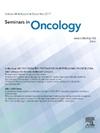Hexokinases in gastrointestinal cancers: From molecular insights to therapeutic opportunities
IF 2.5
3区 医学
Q2 ONCOLOGY
引用次数: 0
Abstract
Hexokinases (HKs) catalyze the first step in glycolysis by transferring a phosphate group to glucose to produce glucose-6-phosphate (G6P); dysregulation of HKs is a feature that leads to altered metabolism within gastrointestinal (GI) cancers—namely, gastric, colorectal, esophageal, and pancreatic cancer. Of note, HKs have been found to exert non-canonical roles beyond metabolism, particularly in regulating cell death pathways such as autophagy and apoptosis in these cancers. In this sense, HK2 promotes hepatocellular carcinoma (HCC) from apoptosis inhibition through the suppression of mitochondrial permeability transition pore formation by interaction with voltage-dependent anion channel (VDAC). Moreover, HK2 expression in HCC tumors decreases immune responsiveness and sensitivity to natural killer (NK) cytotoxicity, thus favoring immune escape. HK2 and co-expressed genes participate in esophageal cancer (ESCA) microenvironment immune response, especially in B cells, CD4 T cells, and macrophages. Most importantly, 3-BP, an HK-2 inhibitor, induces endoplasmic reticulum (ER) stress and disruption of the ER function by the accumulation of free radicals or reactive oxygen species (ROS) and the protein misfolding, thereby causing apoptosis in human HCC. Of note, it has been found that interaction of HK domain containing protein-1 (HKDC1) with ACTA2 (actin alpha 2) is required for the association of signal transducer and activator of transcription 1 (STAT1) with interferon-gamma receptor (IFNG-R) on the plasma membrane, STAT1-phosphorylation, and thus programmed cell death ligand 1 (PD-L1) expression upon stimulation with IFNγ in HCC. This review summarizes the mechanistic involvement of HKs in glycolytic reprogramming, apoptotic resistance, autophagy, immune evasion, metastasis, and drug resistance in GI cancers and the potential of HKs as diagnostic and therapeutic targets.
己糖激酶在胃肠道癌症中的作用:从分子观察到治疗机会
己糖激酶(HKs)催化糖酵解的第一步,将磷酸基转移到葡萄糖中,产生葡萄糖-6-磷酸(G6P);HKs的失调是导致胃肠道(GI)癌症(即胃癌、结直肠癌、食管癌和胰腺癌)代谢改变的一个特征。值得注意的是,已发现HKs在代谢之外发挥非规范作用,特别是在这些癌症中调节细胞死亡途径,如自噬和凋亡。从这个意义上讲,HK2通过与电压依赖性阴离子通道(VDAC)相互作用,抑制线粒体通透性过渡孔的形成,从而促进肝细胞癌(HCC)的凋亡抑制。此外,HK2在HCC肿瘤中的表达降低了免疫应答性和对自然杀伤(NK)细胞毒性的敏感性,从而有利于免疫逃逸。HK2及其共表达基因参与食管癌(ESCA)微环境免疫反应,特别是在B细胞、CD4 T细胞和巨噬细胞中。最重要的是,HK-2抑制剂3-BP通过自由基或活性氧(ROS)的积累和蛋白质错误折叠诱导内质网(ER)应激和破坏内质网功能,从而导致人肝癌细胞凋亡。值得注意的是,研究发现含HK结构域蛋白1 (HKDC1)与ACTA2(肌动蛋白α 2)的相互作用是HCC中信号换能器和转录激活因子1 (STAT1)与质膜上干扰素γ受体(IFNG-R)、STAT1磷酸化以及在IFNγ刺激下程序性细胞死亡配体1 (PD-L1)表达相关联所必需的。本文综述了HKs在胃肠道肿瘤糖酵解重编程、凋亡抵抗、自噬、免疫逃避、转移和耐药中的作用机制,以及HKs作为诊断和治疗靶点的潜力。
本文章由计算机程序翻译,如有差异,请以英文原文为准。
求助全文
约1分钟内获得全文
求助全文
来源期刊

Seminars in oncology
医学-肿瘤学
CiteScore
6.60
自引率
0.00%
发文量
58
审稿时长
104 days
期刊介绍:
Seminars in Oncology brings you current, authoritative, and practical reviews of developments in the etiology, diagnosis and management of cancer. Each issue examines topics of clinical importance, with an emphasis on providing both the basic knowledge needed to better understand a topic as well as evidence-based opinions from leaders in the field. Seminars in Oncology also seeks to be a venue for sharing a diversity of opinions including those that might be considered "outside the box". We welcome a healthy and respectful exchange of opinions and urge you to approach us with your insights as well as suggestions of topics that you deem worthy of coverage. By helping the reader understand the basic biology and the therapy of cancer as they learn the nuances from experts, all in a journal that encourages the exchange of ideas we aim to help move the treatment of cancer forward.
 求助内容:
求助内容: 应助结果提醒方式:
应助结果提醒方式:


